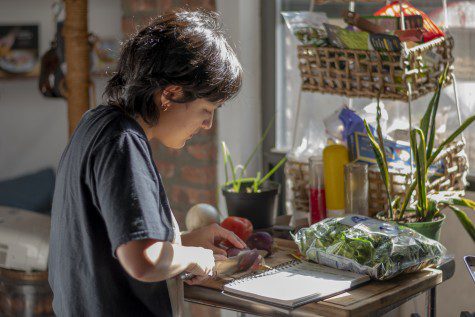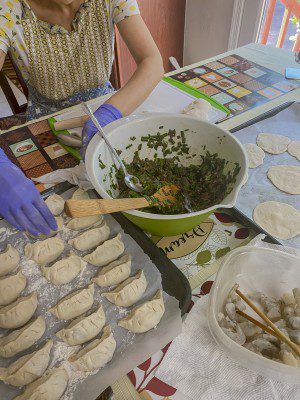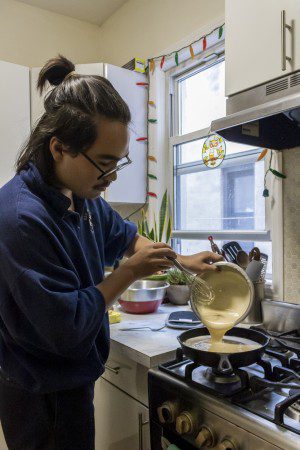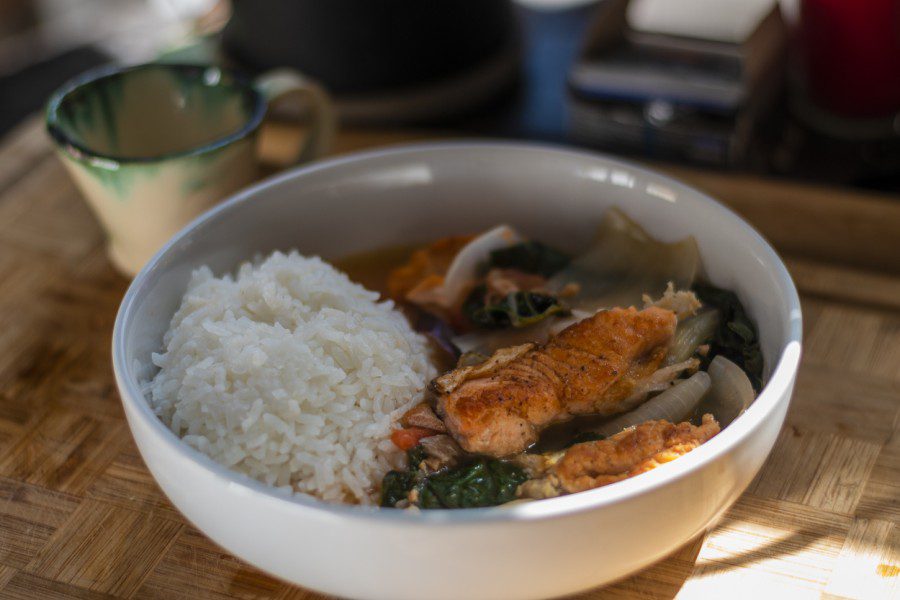Summers in India meant standing in the kitchen watching my grandmother cook fish, and sitting at the dining table waiting for its smell to drift in and the plate to land on the table. Cooking was her passion, my mom often tells me, recalling all the meals she made daily.
Those hot, muggy evenings watching someone prepare curry weren’t exclusive to overseas trips during holiday breaks, though I certainly haven’t experienced that particular joy and curiosity since. Throughout the week, my mom would stand in our kitchen at home, wiping her forehead with her sleeve while grabbing turmeric and red chili powder from the cabinet. Rice sat in a steel bowl on the counter with water on top, while chicken pieces on a cutting board waited for their turn in the pot.
As dinner drew near, I’d wander into the room and eye the stove, first asking when we’d be eating, and then engaging her in quick conversation as she stirred the curry. My dad and brother would join us soon after, laughter erupting when my dad asked for a taste of the curry before it was ready. Family dinners continue to be a staple in our home, and up until this past summer, I remained an observer, not a helper.
My mom never showed me how to make Indian food, fearing that if she forced me to learn, I would grow to hate it. She waited for me to take initiative while I waited for her to teach me. Our ways of thinking always missed each other.
After exclusively cooking Western food during my sophomore year, its flavor profile and cooking process became too bland for my liking. I decided it was time to venture into cooking the Indian food that made my childhood, with encouragement and support from my parents.

My mom spent this past summer teaching me recipes from her favorite website. I ran around the kitchen every time we made a different curry, and soon realized how skilled and experienced she was considering the ease in which she moved around the space. When it was my turn to cook an entire meal, it took twice the amount of time as her.
While a childhood of cooking with family is foreign to some, for others it’s a core part of their memories. Tandon junior Lucia Mumma remembers being in the kitchen with their grandmother, mom and dad growing up. This summer marked a change for them, as Mumma returned home to Hawaii and learned how to make Filipino food like sinigang for the first time from their grandmother.
“We got fish from the market, and there’s this little seasoning packet that she hoards in her closet,” Mumma said. “She brought it out and showed me how to make stock, what to do with the fish and what sort of vegetables you could use.”

Mumma also learned that it’s not so hard to make meals in their apartment — but not all dishes translate from one state to the other. They said poke was a regular weeknight dish they would make with their family because of how delicious it tasted.
“It’s the one thing I miss the most when I’m here because it’s hard to get it authentically,” they said. “It’s such a weird thing that people decide to appropriate.”
Poke is supposed to be a simple meal rather than fancy and commodified as seen in poke bars. The lack of affordable ingredients specific to Hawaii in New York City, including the ones used in poke, means they’ve had to adjust their food palate.
“It feels like I’m making a new diet when I’m here, but in some ways, it’s exciting,” Mumma said. “I have new ingredients here and I can share that with my parents.”
Mumma recently made bibimbap in their apartment, and knowing these ingredients are available in Hawaii means they can recommend it to their family across the country.

Due to the lack of Asian markets nearby, Steinhardt sophomore Angela Chou started buying Chinese food from American grocery stores and transforming it into something more authentic, such as dumplings from Trader Joe’s.
“We can make dumplings steamed or fried, but I really like making them steamed,” Chou said. “You put the dumplings in a bowl, boil them up and make a soup with them. Add green onions and salt to the soup. You can make your own side vinegar. I’d add sesame oil.”
Chou often makes Chinese food or orders meals from restaurants when she’s stressed or feeling down as it reminds her of her mother’s cooking. Wontons are another nostalgic food, as her grandmother would regularly make them when she was a child.
“It was funny because she’d say ‘If you’re being good, I’ll make you some wontons,’” Chou said.
Whenever Chou visits China, where her grandmother lives, she knows she’s in store for a homemade, savory meal. But these dumplings evoke other emotions too.
“Sometimes when I eat wontons, it does make me a bit sad because I think of my grandma and how I haven’t visited her for a very long time,” Chou said.
Distance creates complications for the heart. Tisch junior Max Chu explains one particular endeavor that arose last year when a part of his soup was missing. His dad, who usually goes through phases of cooking, had stumbled upon making sourdough and been quite consistent with it.
“That’s the nature of bread — you have to make it every week,” Chu said. “He doesn’t get to drop it. He has to keep the starter alive and feed into it.”
Chu picked up the activity last winter when he was craving soup, but didn’t have access to his dad’s high-quality bread to go with it. He asked his dad to send him a loaf, though it didn’t live up to his expectations after traveling across the country in the mail. Chu then asked his dad for a sourdough starter and kept up with the timely preparations for a few months. By February, he lost the energy to spend eight hours making bread.
“It sort of felt like a betrayal to my father because I wasn’t keeping up with his starter,” Chu said.
The starter died after six months without care. When Chu’s father came to help him move earlier this year, the two were cleaning out his fridge when they stumbled upon the dough.
“He said, ‘I’ll send you another starter,’” Chu recalled with a smile.

With two loaves of bread already made this semester, Chu is leaning back into the process of last year and awaits his starter’s outcome this winter. But sometimes, food isn’t recognized for its importance and impact. Chu, who has always pursued creativity, remembers frequent questioning at family gatherings.
“Where is that coming from? None of us are artists,” Chu said his relatives would often say, though he isn’t sure that’s true. “They’ve spent so long with food that I think they’re all chefs and they’re all artists and artistic chefs. They’re all artists when it comes to food and that’s where my creativity comes from.”
When recipes are passed down through family members, cooking and baking become more than just hobbies. Whether a source of comfort or inspiration, memorable meals make their way into our habits, hearts and homes.


























































































































































